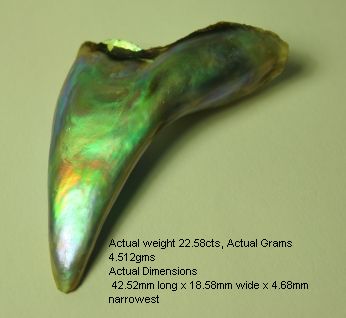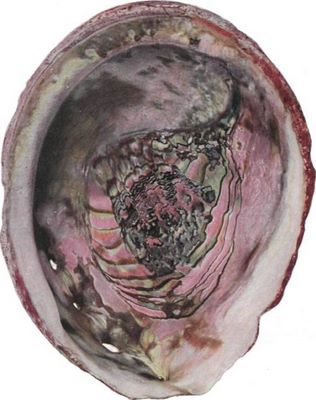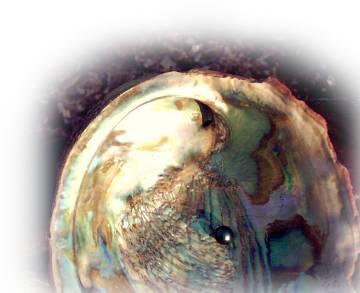|
Iridescent Abalone PearlsAbalone pearls....history, facts...why they're so special.
 Natural Abalone Pearl The ear-shells or abalone (Haliotidae), univalves, attach themselves to the rocks by means of their large muscular disk-shaped foot, which acts like a sucker or an exhaust-cup. These, found on the coasts of California, Japan, New Zealand, and other localities in the Pacific, secrete pearly concretions, sometimes with fine luster. These shells resemble in general outline the form of the human ear. Distinguishing characteristics are the flatly-spiral bowl-like shape, and the regular series of holes in the back near the distal margin, for the admission of water to the respiratory organs. The holes are on the left side and parallel with the columellar lip, and those nearest the apex close up as the shell increases in size. The shells are rough externally, but beautifully nacreous within. In variety and intensity of coloring, the nacre is superior to that of the pearl-oysters, but it is not so harmonious, and it does not form so thick and flat a layer. Abalone Pearls -- Brilliant ColorsAbalone pearls are especially interesting on account of their brilliant and unusual colors. Green predominates, but blue and yellow also occur. Although commonly very small, some of the well-formed ones exceed seventy-five grains in weight, and those of irregular shape may be very much larger. The ear-shells also produce many irregular pearly masses. Their beautiful greenish or blueish tints adapt them for artistic jeweled objects, such as the body of a fly or of a beetle.  Abalone Shell The awabi or ear-shell (Haliotis gigantea), found on the coast of Japan, Korea, etc., yield many pearly forms. This species is much smaller than the California abalones. It has a fairly smooth, nacreous surface, but its value is depreciated by the great size of the marginal perforations, which render useless for commercial purposes all of the shell external to the line of perforations. While its opalescents tints make it desirable for manufacturing into certain styles of buttons and buckles, its principal use is for inlaying work or marquetry, for which it is especially adapted, owing to its fineness of texture and beauty of coloring even when reduced to thin sheets. Abalone Pearls -- Historical Gathering MethodsAt the turn of the twentieth century, probably the most interesting of the abalone fishers was that on the shores of Quelpaerd Island, about sixty miles south of the Korean coast, which is prosecuted largely by the women. Dressed only in a scanty garment, these woman swam out to the fishing grounds, distant several hundred yards in some cases, carrying with them a stout knife and a small sack suspended from a gourd. On reaching the reefs, they dove to the bottom--sometimes to a depth of six or eight fathoms--and by means of the knife, remove the abalones form the bottom and place them in the sack. They may remain out an hour, diving repeatedly until the sack is filled, when they swim back to the shore. Abalone pearls are found only rarely; in one lot of one hundred shells, only five were found bearing pearls two with three pearls each, two with two pearls each, and one with a single pearl. The flesh of this mollusk after it has been cleaned and dried, is quite popular as an article of diet. Although white when fresh, the color changes to a dard red. The pieces of dried flesh, in the form of flat reddish disks four or five inches in diameter, are fastened on slender sticks--about ten to each stick--and displayed in the grocery shops in Seoul and other cities. On the California coast during the first part of the twentieth century were gathered in large quantities for the pearls, for the shells, and especially for the flesh, which can be dried and used for food. The principal fishing grounds were at Point Lobos in Monterey County, and along the shores of Catalina and Santa Rosa islands in Santa Barbara County, with smaller quantities form Half-moon Bay and from the rocks along the shores of Mendocino County. Abalone Pearls -- Gathering AbaloneAt low tide the fishermen would wade out in shallow water, and, by means of a knife, separate the mollusk from its resting place. Unless this is done quickly and before the mollusk has time to prepare itself for the attack, it closes down on the rock by means of its sucker-like foot, from which it cannot be removed without breaking the shell. A story is told at Santa Barbara of a Chinese fisherman having been drowned off one of the outer islands by having a his hand caught underneath the shell of an abalone. Japanese fishermen introduced the use of diving-suits in taking the mollusks in three fathoms of water; but in March, 1907, the California legislature interdicted this form of fishery. That legislature also interdicted the capture of black abalone measuring "less than twelve inches around the outer edge of the shell, or any other abalone, the shell of which shall measure less than fifteen inches around the outer edge." Abalone Pearls -- Preparing the Meat for UseThe animal is removed from the shell by thrusting a thin blade of soft steel between the flesh and the shell, and thus loosening the great muscle. The flesh is salted and boiled, and then strung on long rods to dry in the open air. When properly cured, the pieces are almost as hard and stiff as sole leather. At the beginning of the twentieth century, most of it was packed in sacks and exported to China, but large quantities were sold on the Pacific coast at from five to ten cents per pound. The catch in 1908 was much less than in the 1860's.  Abalone Shell with Tahitian Pearl Abalone Pearls -- Early ValuesMany pearly masses are obtained from the abalones, and a few of these are of considerable beauty. Some are very large, measuring two inches in length and half an inch or more in width; but they are rarely of good form, and their value is commonly far less than that of choice Oriental pearls. Owing to their irregularity in form, they are scarcely suitable for necklaces. One of the best necklaces of these pearls ever brought together sold in 1900 for $2,000; but individual specimens in 1900 have exceeded $1,000 in market value. Abalone Pearls -- Early Experiments at CulturingExperiments in growing pearls in the abalone or Haliotis were made in 1897 by Louis Bouton, an account of which was given at the meeting of the Paris Academie des Science in 1898. The tenacity of life in this mollusk makes it especially desirable for experiments of this nature. Through small holes bored into the shell, pellets of mother-of-pearl were inserted and placed within the mantle, the small holes being afterward closed up. Other nacreous pellets were introduced directly into the bronchial cavity. The objects were soon covered with thin, pearly layers, resulting in a few months in spheres of much beauty, resembling somewhat the pearls naturally produced by this mollusk. In six months, according to M. Bouton, the layers became of sufficient thickness to be attractive. Within limitations, the size of the pearl produced is in proportion to the length of time it is allowed to remain within the mollusk. Abalone Pearls -- Early UsesDr. T. Nishikawa writes in 1908 that pearls were used in Japan for ornamental purposes more than a thousand years ago. Large abalone pearls are found in images of Buddha made in 300 A.D. The structure of pearls from univalve mollusks, such as the conch, the abalone, etc, as well as those from some bivalves, as the Pinna, for instance, differs form that of the true pearls formed in species of Margaritifera. Instead of alternate layers of conchiolin and of carbonate of lime, many of these have an alveolar structure. Special thanks to Kunz and Stevenson for their abalone information published in 1908. |











